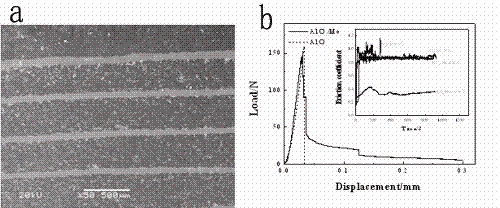High-performance structural ceramics possess many excellent properties, such as high temperature resistance, wear resistance, anti-corrosion, high strength and anti-oxidation. They are considered to be potential candidates for high-temperature tribological applications. High temperature ceramics should be low density structural materials which can work under 1000℃ and possess high strength and anti-corrosion properties. At present, the intrinsic embrittlement and decrease in mechanical properties resulted from tribological design of ceramic materials have limited the application of ceramic materials in lubrication under high temperature.
Starting from micro/nano composite materials, the researchers at the Lanzhou Institute of Chemical Physics (LICP) of the Chinese Academy of Sciences (CAS) have successfully prepared Al2O3/Mo composites with laminated structure by applying the design principle of bionic composites.
 |
| (a) SEM photograph and (b) load–displacement curves and effect of temperature on friction coefficients of Al2O3/Mo laminated composite. (Image by HU LItian et al.) |
The composites consist of a weak interfacial layer of molybdenum with thickness of 65 m, which results in high fracture toughness and low friction coefficient. The bending strength of the material reached the properties similar to those of general monolithic Al2O3 ceramics, and the fracture toughness is 1.6 times higher. The friction coefficient of the material can be reduced by approximately 62.6% below than that of the monolithic Al2O3 ceramics to 0.34 at 800℃. The lowest friction coefficient values of 0.25 can be reached at 800℃, 70 N, and 5 Hz.
The Al2O3/Mo composite gained good self lubricating performance, which can be attributed to the presence of weak interfacial layer and the formation of MoO3 during the sliding friction at high temperature. These excellent tribological and mechanical properties enable it to have numerous potential applications in high technology as a structural material.
The work has received support from National Program on Key Basic Research Project of China (973 Program), National Natural Science Foundation of China, Western Light Program of the Chinese Academy of Sciences.
The findings have been published in Wear (Wear 2012, 280-281: 1-4).


